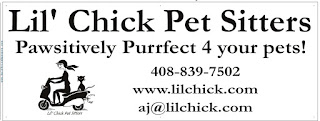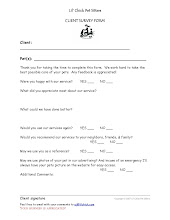THE HOLIDAY SEASON AND YOUR PETS SAFETY
The holiday season is a time for celebration. It is a time when family and friends gather together to share in the joys and spirit of the season. For a great many of us our pets are included among our entourage of those that we hold nearest and dearest to our hearts. Unfortunately the holidays are rife with potential safety hazards for our pets. By implementing some of the following basic preventative measures we, as pet owners, can help to ensure that our pets are able to enjoy the holiday season with us in comfort.
Social Gatherings Social gatherings are a common occurrence during the holiday festivities. Such events can prove to be very chaotic and stressful to our pets. It is extremely important to pay close attention to our pet's mood and behavior in order to avoid potentially traumatic and disastrous consequences.
Providing our pets with a safe, quiet room to escape to when the hustle and bustle of social events becomes too much is a must. If your pet does not particularly enjoy partaking in these gatherings then it would be ideal to place them in a pet-safe room for their comfort and your peace of mind. Make certain to include their favorite toys, fresh water, and a comfortable place for them to relax. It is very important to make frequent checks and interact with them often so as to prevent them from feeling left out or abandoned.
Caution when Cooking
The preparation of meals and goodies for the holiday season can pose potential hazardous situations for your pet. With a pet constantly underfoot there is a much greater risk that they will be exposed to the spilling of hot liquids or the consumption of foods that may put their health at risk. It is highly recommended that pets be kept out of the vicinity of the kitchen or cooking area.
Dangerous Foods
Our pets have very sensitive digestive systems that are not accustomed to our particular diets as humans. Foods classified as drippings are far too rich and fatty for our pets. They may pose a considerable health risk to our furry and fluffy companions.
During the holiday season it would be a wise and kind gesture for pet owners to bake or purchase vet-approved, pet-safe treats for their pets. Speak with your veterinarian regarding pet-friendly, pet-healthy treats that are available on the market. You may wish to create a list of ingredients and products that are toxic to your pet so that if you plan on creating treats for them you can avoid potential disaster.
Poultry bones have the propensity to splinter and lead to severe abdominal pain, expensive hospital visits, and even the death of your beloved pet. They also pose a serious choking hazard. Avoid giving your pet poultry bones at all costs.
Chocolate, candy, and cookies although sweet to the taste are toxic to your pet. Pets should never be given alcohol for the results could be deadly. Treat your pets to only vet-approved, pet-safe products. When having company over make certain that your guests understand the rules when it comes to feeding your pet. Direct them to the pet-safe treats that you have on hand or simply place your pet in another room to avoid potential misunderstandings and disaster.
Toxic Holiday Plants
Ivy, holly, mistletoe, balsam, juniper, cedar, hibiscus, and poinsettias are just a few of the common holiday plants that are toxic to our pets. Remove them completely or place them far out of the reach of your pets. Monitor them closely if they must be in the general vicinity of such items.
Visiting Pets
First and foremost it is imperative that pet owners always check with those they intend to visit to ensure their pets are welcome. Never leave your pet in a vehicle for extended periods of time unsupervised for this only invites potential disaster.
It is important to remember that bringing your pet to a strange, new home may produce intense feelings of stress and anxiety. Be very aware of your pet's mood and behavior. If they exhibit signs of uneasiness or timidity then remove them from the situation immediately. There is nothing worse than an inconsiderate pet owner.
If you intend to leave home for the holidays consider boarding your pet at a reputable facility or hiring a reputable pet sitter. Oftentimes it is better for our pet's health and happiness if they are able to stay within the safety and security of a familiar place rather than be uprooted and taken to a strange location. As much as we want to share this very special time with our furry companions sometimes we need to put their best interests ahead of our own desires.
Regular Exercise and Feeding Schedule
It is absolutely essential to your pet's health and happiness that they are kept on a regular feeding and exercise regimen. This will help to ease the stress of the increased activity and chaos surrounding them during this time of year. It will allow them to more thoroughly enjoy and partake in the spirit of the season. This is quality time that you and your pet can spend together that will help to keep them from feeling left out and alone.
Always make certain that fresh, clean water is available to your pet at all times. It is not uncommon with the hustle and bustle of the holiday season for your pet to suffer from the ill-effects of dehydration. This is a problem that can be easily avoided.
Christmas tree
During the Christmas season many homes bolster the image of a beautifully decorated tree sitting majestically within the confines of a warm, inviting atmosphere. With pets and even small children about it would be wise to anchor the tree to the wall or ceiling using fishing line or twine to prevent tipping or falling accidents. Not only does this prove to be a potentially disastrous consequence for the pet involved but it can leave the home owner with an awful mess to clean up and the possibility of the loss of some very sentimental items.
Non-breakable, non-sentimental ornaments should be placed near the bottom of the tree for the pet's safety and the pet owner's sanity. Tinsel and angel hair (spun glass) should be removed from your pet's presence since they have the potential to cause intestinal blockage or other seriously dangerous consequences.
Snow flock and artificial snow are dangerously toxic if inhaled or consumed by your pet. Replacing metal hooks with pet-safe twine or yarn is a good practice as is sweeping up and removing all loose pine needles. Ingestion of these items can lead to puncture holes in the stomach and intestines with possibly fatal consequences.
Bacteria that can build up in stagnant tree water and other chemicals added to preserve the life of the tree are toxic to pets. Make certain to securely cover the tree stand to prevent access by pets at all times. Making sure that they always have access to fresh, clean water is also a deterrent.
The beautiful decorative lights on the lower branches of a Christmas tree need to be kept from within your pets reach to avoid the ill-effects of electric shock as a result of chewing or entanglement. Placing them on the inner branches of the tree can help deter your pet's curiosity.
Christmas Decorations
Snow globes pose a potential risk to pets because of the toxic nature of the antifreeze-like ingredients within this holiday decoration. If your pet is granted access to the liquid portion of the snow globe due to breakage the possibility of death is greatly increased. Antifreeze typically has a sweet taste to it making it appealing to the unsuspecting pet. Immediately remove your pet from the area and clean them thoroughly making sure no lingering effects of the liquid are left behind. Keep your pet away from the area until you have properly and effectively removed all potential hazards from your pet's reach. The shards of thin, sharp glass also pose a serious threat to your pet's health.
Electrical cords must be covered properly and securely. Unused electrical sockets should be covered or sealed off to protect against electric shock when it comes to curious pets and children.
Some pets love to chew on pine cones but these seemingly harmless structures are anything but. The sharp protrusions and tough nature of pine cones can injure your pet's gums and pose a danger when consumed as they cause problems within the intestinal tract. A trip to the vet can become costly.
Lit fireplaces and candles pose a very dangerous fire hazard to you and your pet. Never leave such situations unattended and always prevent your pet from accessing these areas. Place candles far out of reach of a wagging tail, fluttering wings, or a curious nose.
Stocking Stuffers
Do not allow pets to open gifts designated for people since there is the possibility they will consume or become entangled in the ribbon or other potentially harmful substances. Gift wrapping supplies should be kept out of reach of pets. Do not tie ribbons around your pet's neck for they pose a potential choking hazard either by consumption or entanglement.
There is also the possibility of internal obstruction which could become fatal. Instead provide your pet with their own stocking filled with vet-approved, pet-safe toys and treats so that they may partake in the festivities along with your family. Spend quality time with your pet and involve them in the activities in a safe and secure manner.
Outdoor Dangers
Rock salt is commonly used during the wintry months of the holiday season. This substance is rough on your pet's paws and skin. It can lead to a severely painful drying out and cracking of the skin and paw pads. Avoid exposing your pet to rock salt whenever possible. Clean your pet's feet and fur thoroughly after coming inside.
 The cold, wet weather can pose serious health risks to your pet. Whenever possible keep pets indoors during the winter months. Outdoor pets should be cared for properly and provided adequate shelter with extra precautions in place for the harsh elements. Watch your pets carefully when they are outdoors for signs of any ill-effects that may be a result of the weather.
The cold, wet weather can pose serious health risks to your pet. Whenever possible keep pets indoors during the winter months. Outdoor pets should be cared for properly and provided adequate shelter with extra precautions in place for the harsh elements. Watch your pets carefully when they are outdoors for signs of any ill-effects that may be a result of the weather.Increased stress and anxiety during the socially active and chaotic times of the season may heighten your pet's chance at escape. Make certain your pets are fitted with the proper I.D. tags to ensure a speedy return home if such unforeseen circumstances were to come about unexpectedly. Watch them closely and be aware of their behavior.
Taking the necessary precautions during the holidays will help to ensure that you and your pet will enjoy the beauties and wonders of the season. The safety and happiness of everyone involved will aid in making this time of year far more enjoyable for everyone. Check with your veterinarian for any further actions you can take to ensure that you and your pet are able to spend a healthy holiday season together. Good luck and a Happy and Sfae Holiday Season!
WWW.LILCHICK.COM
408.839.7502
AJ@LILCHICK.COM
Source: http://www.sspca.org/HolidayHazards.html
















